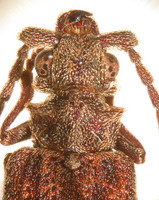Paracupes
Thomas Hörnschemeyer


This tree diagram shows the relationships between several groups of organisms.
The root of the current tree connects the organisms featured in this tree to their containing group and the rest of the Tree of Life. The basal branching point in the tree represents the ancestor of the other groups in the tree. This ancestor diversified over time into several descendent subgroups, which are represented as internal nodes and terminal taxa to the right.

You can click on the root to travel down the Tree of Life all the way to the root of all Life, and you can click on the names of descendent subgroups to travel up the Tree of Life all the way to individual species.
For more information on ToL tree formatting, please see Interpreting the Tree or Classification. To learn more about phylogenetic trees, please visit our Phylogenetic Biology pages.
close boxIntroduction
Two extant species have been described in this genus: Paracupes brasiliensis Kolbe, 1898 occurs in the provinces Bahia, Minas Gerais and Parana in the southwest of Brazil (South America). Paracupes ascius Neboiss, 1989 is only known from its type locality in central Ecuador (South America).
The only known fossil species is Paracupes svitkoi Lubkin, 2003 from the Cretaceous of New Jersey.
Characteristics
Both extant species are very similar in body shape and coloration. Specimens of P. brasiliensis can be between 6 and 16 mm long. The holotype of P. ascius, which is the only known specimen, is 10.4 mm long and 3 mm wide.
Paracupes is easily identified by the characteristic small and strongly anteriorly inclined head tubercles above the antennal insertions. Median and posterior head tubercles, which are so prominent in Cupes capitatus and some other Cupedidae, are absent. The body is long and slender, with parallel sides. The pronotum is comparatively small with prominent anterior corners. In cross-section the body is semicircular, which is uncommon in Cupedidae or Archostemata and similarly found only in Priacma serrata.
Discussion of Phylogenetic Relationships
According to Hörnschemeyer (2009) Paracupes is the sistergroup of Priacma. This interpretation is based mainly on head and mouthpart characters. For instance, the shape and size of the mandible are very similar in both genera. However, these similarities could also be interpreted as plesiomorphies of Cupedidae. In this case, support for a sistergroup relationship of Paracupes and Priacma would be quite weak, suggesting that these species are just "primitive" representatives of Cupedidae.
References
Crowson, R.A. 1962. Observations on the beetle family Cupedidae, with descriptions of two new fossil forms and a key to the recent genera. Annals & Magazine of Natural History 5, ser. 13, No. 51: 147-157
Gestro, R. 1910. Cupesidae, Paussidae. Coleopterorum Catalogus. Vol. 4 Pars 5.
Hörnschemeyer, T., 2009. The species-level phylogeny of archostematan beetles - where do Micromalthus debilis and Crowsoniella relicta belong? Systematic Entomology 34(3): 533-558.
Kolbe, H. J. 1898. Eine neue Gattung der Cupesiden. Entomologische Nachrichten 12: 179-180.
Lubkin, S. H. 2003. Paracupes svitkoi (Coleoptera: Cupedidae), a new species from the Cretaceous of New Jersey. Acta Zoologica Cracoviensia 46:189-194.
Neboiss, A. 1984. Reclassification of Cupes Fabricius (s.lat.), with descriptions of new genera and species (Cupedidae: Coleoptera). Systematic Entomology 9: 443-477.
Neboiss, A. 1989. New species of Archostemata (Coleoptera, Ommatidae, Cupedidae). Revue francaise Entomologie (N.S.). 11(3): 109-115.
Vulcano, M.A. & Pereira, F.S. 1975. Cupesidae (Coleoptera). Archivos do Instituto Biologico, Sao Paulo, Brasil 42: 31-68.
Title Illustrations

About This Page

University Göttingen, Institute for Zoology & Anthropology, Dept. Morphology & Systematics
Correspondence regarding this page should be directed to Thomas Hörnschemeyer at
Page copyright © 2011
 Page: Tree of Life
Paracupes .
Authored by
Thomas Hörnschemeyer.
The TEXT of this page is licensed under the
Creative Commons Attribution-NonCommercial License - Version 3.0. Note that images and other media
featured on this page are each governed by their own license, and they may or may not be available
for reuse. Click on an image or a media link to access the media data window, which provides the
relevant licensing information. For the general terms and conditions of ToL material reuse and
redistribution, please see the Tree of Life Copyright
Policies.
Page: Tree of Life
Paracupes .
Authored by
Thomas Hörnschemeyer.
The TEXT of this page is licensed under the
Creative Commons Attribution-NonCommercial License - Version 3.0. Note that images and other media
featured on this page are each governed by their own license, and they may or may not be available
for reuse. Click on an image or a media link to access the media data window, which provides the
relevant licensing information. For the general terms and conditions of ToL material reuse and
redistribution, please see the Tree of Life Copyright
Policies.
- First online 10 February 2006
- Content changed 23 July 2011
Citing this page:
Hörnschemeyer, Thomas. 2011. Paracupes . Version 23 July 2011 (under construction). http://tolweb.org/Paracupes/9006/2011.07.23 in The Tree of Life Web Project, http://tolweb.org/











 Go to quick links
Go to quick search
Go to navigation for this section of the ToL site
Go to detailed links for the ToL site
Go to quick links
Go to quick search
Go to navigation for this section of the ToL site
Go to detailed links for the ToL site